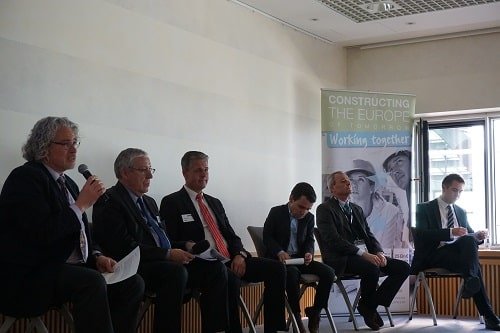- From steel and hydraulics to all-integrated customer services
- Technology leadership will remain most critical asset
- Heavy impact of EU regulation continues to be felt
Munich – The European construction equipment industry is confidently looking towards the future and ready to embrace the transition into the digital era, with a stronger-than-ever focus on technology leadership and customer needs. “We are determined to serve our customers well in the midst of multiple trends facing our industry. Being at the technical forefront is critical for us”, said Bernd Holz, CECE President and sales director of Amman Europe (North).
Holz spoke at a large industry conference organised by CECE and McKinsey & Company at bauma, the international construction equipment trade fair held every three year in Munich. The conference served to launch McKinsey’s new report on the sector, providing the most comprehensive perspective on the sector available to date. CECE supported the report through a survey of member companies. At bauma, a panel of industry executives and experts discussed the findings and took questions from the floor.
Main findings
The report’s main findings are that the European construction equipment manufacturers are on the brink of profound transformation, driven by external factors such as rising competition from emerging markets, tightening regulatory requirements, the gradual growth of rental as primary customer segment for several machine types, weak economic recovery and the advancements of telematics and data-driven solutions. These trends are converging and collectively hitting the industry at once, with the potential to change the competitive landscape. The sector, concludes McKinsey, is about to shift priority from being operations focussed to becoming customer centric.
“As an industry, we are embracing the transformation McKinsey describes”, said Holz. “We’ve used the past years to make our production leaner and sustain our strength to compete globally. Now, we are shifting from selling just steel and hydraulics to an offering of more all-integrated services to support customers in executing their work. The key for OEMs will be how quick they can shift and implement the foreseen future in their strategy, and to ready ourselves for the era of digitization.”
“Of critical importance is our technology leadership”, concluded Holz. “Many of us are planning to increase our spending on R&D as part of our shift to greater customer orientation. Technology is our heart and soul.” Holz called on the European legislator to set the framework conditions to make sure the engineering champions of Europe, such as the construction equipment industry, can reap their potential.
Technology trends
The two most important technology trends for the sector in the next 5 years as emerging from the survey are the advancement of telematics and emissions technology. Telematics and remote-monitoring are closely linked with better understanding as well as serving customers. Emissions reduction technology is closely related to regulation and has been a focus for manufacturers for several years.
Increasing environmental aspirations and requirements ranked 4th in the top-10 of major trends expected to impact the industry, with specific product segments ranking this trend first or in the top-3. “We feel the heavy impact of the high volume of European regulations in our operations every day”, said Holz. “We’ve come far in cleaner emissions technology and there will indeed be room now to divert resources to other technologies. But the latest stage in exhaust emissions law still has to be implemented on our production lines, and will continue to strain our budgets. Given the huge variety in our product offering, the complexity we’re facing should not be underestimated.”
A key European sector
The report characterizes the construction equipment industry as “low-volume – high complexity” sector, producing over 100 machine types and with numerous OEMs active, all the way from large multi-national players to global niche players and local manufacturers. With over 350 corporate machinery groups in Europe, operating under more than 500 brands, the sector collectively turns over 35 to 40 billion euro in their European businesses.
The sector’s strength and diversity is shown by the fact that almost 75 percent of OEMs turn over less than 100 million euro a year, however competing successfully with their multi-billion peers in both local and niche markets. A true export powerhouse, 2.5 to 3 times more construction machines are exported than imported, whereas on average exports in the machinery sector only outweighs imports by 10 to 15 percent. Over 85 percent of all construction equipment production capacity is located in Europe, with over half of OEMs producing only in Europe. In all, the sector employs over 150.000 people directly, and two to three times more indirectly.
